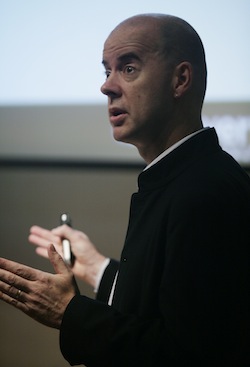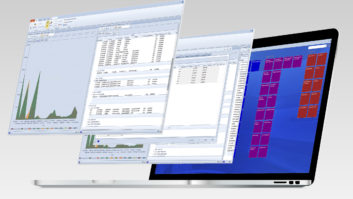
Reducing the costs of delivering to more than 10 VoD platforms with 14 different languages and eight subtitle languages. Presentation by Darren Breeze, Discovery Communications, supported by George Boath, sales director, Telestream.
Darren Breeze, Director of Broadcast Engineering at Discovery Communications Europe, described how an IT workflow has transformed the company’s expanding business in producing masters for Video on Demand (VoD) from its Chiswick Park playout centre in London.
Delivering to more than ten VoD platforms, Discovery had been struggling with a system requiring a series of expensive, time-consuming and labour-intensive steps. First, source media files held in Apple QuickTime (QT) 7 50i format were copied from the centre’s Omneon servers onto tape. Next the ad breaks were edited out and the content reformatted as required, followed by playback through a subtitle inserter to Digital Betacam tape, which was then shipped to the VoD platform for ingest.
What made streamlining particularly daunting was the sheer quantity of variables. Source pictures could be standard or high definition in one of three aspect ratios (16:9 full height anamorphic, 16:9 Letter Box or 4:3), stereo or mono, and any of 23 languages (14 audio, 9 subtitled). Furthermore, a plethora of output file formats was required, as no real established standards exist for VoD in the EMEA region, said Breeze.
Discovery’s master stroke was to start by enshrining all the pertinent source and delivery variables – including the destination country, whether subtitles are needed, which languages, ad break patterns and so on – within an XML file work order for each task, based on the selection of known profiles.
This enables all downstream stages to be performed without recourse to scribbled notes or human memory, via an array of three Telestream FlipFactory conform engine nodes running on HP BL blades with dual 3GHz quad core CPUs to generate the edit masters, with a Signiant multi-agent system handling workflow and delivery, and a 20TB four-node storage array from Isilon. A browse copy is also made of every VoD master, facilitating swift programme access at any point.
The reduction in operating costs has been dramatic, said Breeze, who revealed that the system investment was repaid with the savings from just one large (400 show) transcoding job. Smaller service providers will benefit too, as the reduced cost of entry means that new platforms can be deployed with minimal cost, allowing businesses to ‘take a chance’ and by making smaller niche deals more viable. Service and content delivery is also faster and more predictable.
The next steps will see Discovery migrating increasingly to HD with a system expansion including more FlipFactory servers, delivery to Apple iTunes, compatibility with ProRes (Apple’s video editing codec launched with Final Cut Studio 2 in 2007), DVB subtitles, and finally Dolby E, ushering in what Breeze cheerfully described as “The world of pain called metadata.” – Richard Dean







